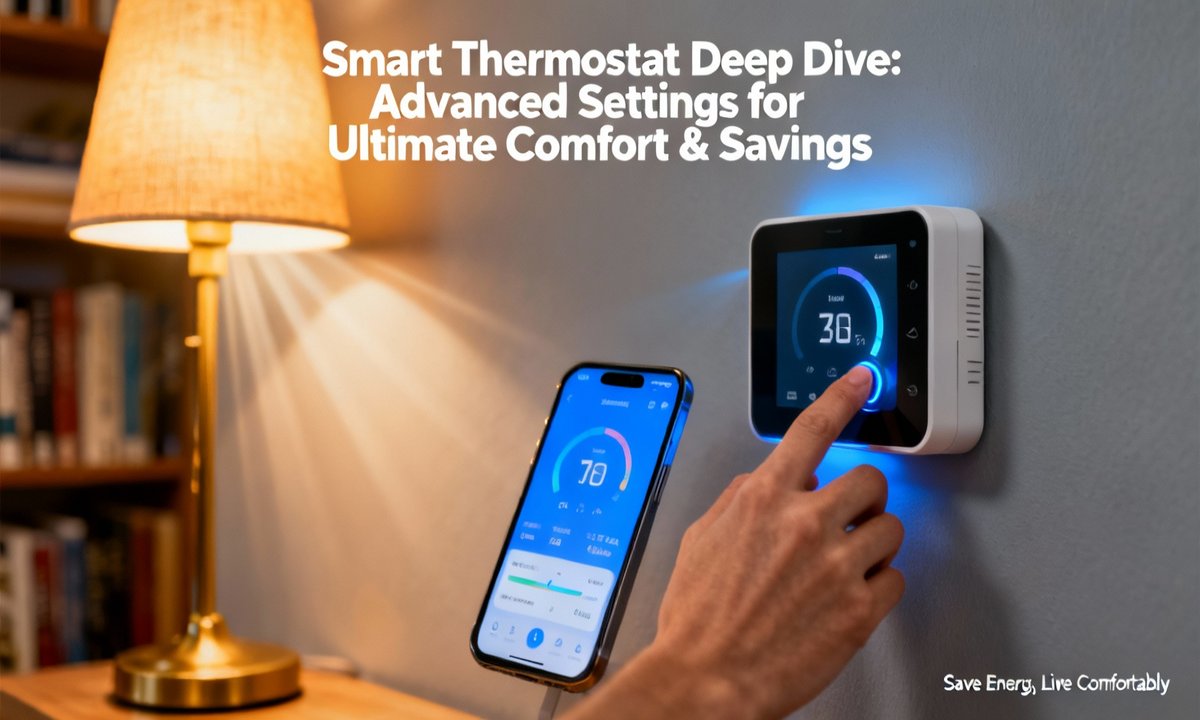Modern smart thermostats are far more than simple temperature regulators; they are sophisticated instruments crafted to personalize your home environment while simultaneously lowering utility expenses. For homeowners across the U.S., delving into their advanced settings can reveal new levels of comfort and impressive energy efficiency. This comprehensive guide aims to demystify programming and expert optimization, enabling you to fully leverage features from leading brands.
Unlocking Your Smart Thermostat: Modes and Features
These innovative devices seamlessly connect to your home’s Wi-Fi, gradually learning your daily routines and personal preferences. Many are ENERGY STAR certified, adhering to U.S. standards, and can potentially reduce your annual HVAC expenses by approximately 8%.
The true power of these thermostats lies in their meticulously designed settings, encompassing features like precise scheduling, operational thresholds, and multi-stage control. These allow for a highly customized comfort experience while significantly enhancing energy savings, helping you master programming your system.
Various modes are typically supported, such as Home, Away, Sleep, and Vacation, each tailored to optimize comfort based on whether your home is occupied or the time of day. Many models also integrate adaptive learning, geofencing capabilities, and connectivity with popular virtual assistants for added convenience.
These advanced functionalities complement wider home improvements. To understand how your thermostat contributes to a holistic energy strategy, consider exploring smart home upgrades for energy savings.
Step-by-Step Guide to Advanced Programming
Tailoring Your Daily and Weekly Schedules
Establishing daily and weekly schedules forms the bedrock of efficient smart thermostat use. Begin by identifying your household’s specific routines, such as times for waking, leaving, returning, and sleeping. During weekdays, you might prefer lower temperatures while away, whereas weekends often call for different settings with more time spent at home.
Advanced models offer the flexibility to program multiple periods per day, often up to four, ensuring that your home’s climate perfectly aligns with your changing lifestyle. This precise control can be accessed through your thermostat’s dedicated application.
Setting these schedule blocks is straightforward. Navigate to the scheduling option within your app, input the desired times for each period, and then assign your preferred temperature. After saving, it is advisable to test these settings over a few days and make any necessary adjustments for optimal comfort.
For a wider perspective on impactful energy improvements for your residence, delve into our advanced smart home energy efficiency guide.
Managing Manual Overrides and Holds
Life’s unpredictability means your schedule isn’t always rigid. There will be times you need to temporarily or permanently adjust programmed settings. Modern thermostats simplify this with a “hold” function, accessible via a button press on the device or through its mobile application. This action maintains a specific temperature until it is manually released or until the next scheduled period begins.
A clear “Hold” icon typically appears on the display, indicating that a temporary setting is active. Permanent holds prove particularly useful for extended absences, like vacations, or for irregular household routines. Remember to deactivate these holds upon your return to prevent unintentional energy usage.
Embracing Remote Access and Geofencing
A key convenience of smart thermostats is the ability to control them remotely. Through smartphone or web applications, you can adjust settings from any location, making it ideal for returning home early or preparing your space for guests. This seamless connectivity enhances both comfort and flexibility.
Geofencing offers another remarkable advantage; your thermostat can detect when all household members are away, typically by using smartphone GPS data. It then automatically transitions into an energy-saving Away mode. As you approach a defined virtual boundary around your home, comfort settings reactivate, ensuring your space is welcoming upon arrival. This intelligent integration significantly boosts convenience and savings, especially for those with unpredictable schedules, as recognized by ENERGY STAR.
Threshold and Staging Settings Explained
Optimizing HVAC Thresholds
Threshold settings dictate how promptly your thermostat responds to changes in temperature. These differentials, often set in degrees Fahrenheit, are crucial for preventing your HVAC system from short cycling, which reduces wear and unnecessary energy consumption. For instance, specific guidance is available for adjusting temperature differentials to avoid rapid system starts and stops.
You can typically configure these thresholds through your thermostat’s application or directly via its device menu. The heat threshold defines the minimum temperature drop before heating activates, while the cool threshold sets the minimum rise before cooling engages.
Even minor adjustments, sometimes as small as 0.5°F, play a significant role in striking the perfect balance between sustained comfort and enhanced efficiency. To further enhance your smart home’s capabilities, explore our guide on smart home security devices.
Understanding Thermostat Staging
Staging becomes vital if your home utilizes a multi-stage furnace or air conditioner. This feature allows the thermostat to intelligently decide when to activate the first, lower-power stage of your system, only escalating to higher stages if more heating or cooling is genuinely required. Proper adjustment of staging settings can significantly improve both cost savings and overall comfort.
By preventing your system from running at its maximum capacity unnecessarily, staging optimizes energy use. It is always recommended to consult your specific equipment’s manual to ensure the correct staging parameters are selected for your system.
Managing Fan Operation and Humidity
Beyond temperature, the fan settings offer another layer of control. Setting it to “Auto” ensures air circulation only when heating or cooling is actively running, which typically conserves energy. Opting for “On” provides continuous air movement, which can be beneficial for individuals with allergies or in homes that experience consistent humidity challenges.
Many advanced thermostats now incorporate sophisticated humidity control features. You can establish specific relative humidity limits, for example, between 40% and 60%, to enhance comfort. This helps in preventing excessive dryness during winter months and managing excess moisture during the summer, contributing to a more balanced indoor climate.
Custom Comfort Scenarios: Home, Away, Sleep, and More
Optimizing for Home Mode
Home mode represents your primary comfort setting when your living space is actively occupied. The objective here is to prioritize comfort with considerate temperature adjustments. You can customize the set points in Home mode to align perfectly with your family’s specific preferences, creating an ideal environment during your active hours.
Leveraging Away and Vacation Modes
The Away mode is strategically designed to conserve energy by moderating heating or cooling when your home is vacant. For longer absences, Vacation mode offers an even more aggressive approach, maintaining minimal-safe temperatures over extended periods. Both modes are typically configured through your thermostat’s app, allowing you to program specific start and end dates.
This ensures that your preferred comfort settings automatically resume just before your return. For additional seasonal adjustments and strategies to maintain year-round comfort, explore our energy-proofing your home for winter resource.
Personalizing Sleep Mode
Sleep mode allows for customized temperature set points, often differing slightly from your daytime preferences. For example, during summer, you might prefer to cool your bedroom to a comfortable temperature without over-cooling other parts of the house. Utilizing zone controls or smart sensors can effectively direct energy precisely where it is most needed, enhancing nighttime comfort.
Optimizing for Energy Savings and Efficiency
Harnessing Adaptive Learning Algorithms
Many smart thermostats utilize advanced adaptive learning algorithms that analyze your adjustments and subsequently modify future schedules to reduce costs and enhance comfort. These systems are capable of learning your preferences within a matter of days or weeks, continuously refining their operation.
To achieve the best outcomes, it is recommended to allow these algorithms to function optimally. Minimize manual overrides unless absolutely necessary, and if available, ensure all household members use the dedicated smartphone applications to maintain the accuracy of the AI’s learning process for scheduling.
Integrating Geofencing and Automation
Enhance your system’s efficiency by combining geofencing with various zone sensors, such as room occupancy or window/door sensors. This advanced level of automation guarantees that energy is not expended on heating or cooling areas that are empty or compromised. This creates a truly responsive and energy-conscious environment.
For further insights into deploying smart technology across your entire home, consult our guide on advanced smart home energy efficiency.
Making Seasonal Adjustments
Adjusting your thermostat settings with the changing seasons is key to maximizing efficiency. In summer, consider setting temperatures higher, up to 78°F when home and around 85°F when away. Conversely, during winter, aim for lower temperatures, such as 68°F when home and 60°F when away. The ENERGY STAR seasonal guidance provides an excellent foundation for these adjustments.
To further optimize your cooling efforts during peak summer months, explore essential HVAC maintenance tips to cut AC costs.
Embracing ENERGY STAR Benefits
The most significant energy savings are realized when efficient settings are combined with consistent HVAC maintenance and strategic system upgrades. If you are seeking additional ways to enhance your home’s energy performance, our curated list of smart home upgrades for energy savings offers high-impact improvements.
Alerts and Maintenance Reminders
Beyond temperature regulation, smart thermostats serve as proactive guardians for your home’s climate system. They deliver timely alerts and reminders crucial for maintaining smooth operation, notifying you about essential tasks like filter changes or detecting unusual temperature fluctuations. These notifications are invaluable for preempting and avoiding potentially expensive repairs.
Always heed the prompts displayed in the dedicated app or directly on the device’s screen, and refer to the manufacturer’s guides for comprehensive troubleshooting advice. Discover more practical insights for home care and maintenance by exploring various DIY home repair hacks.
Seamless Integration with Other Smart Devices
The majority of smart thermostats offer effortless connectivity with leading smart home platforms, including Amazon Alexa, Google Assistant, and Apple HomeKit. This expansive integration significantly broadens your home automation capabilities, enabling synchronized routines and voice commands that control lighting, security, and climate settings all at once.
Further enhance efficiency by connecting your thermostat with window, door, or motion sensors. This intelligent integration ensures that your HVAC system will not operate if a window is open or a room remains unoccupied, preventing unnecessary energy expenditure. For additional ways to fortify your smart home, review our comprehensive guide on smart home security devices.
Troubleshooting and Reset Procedures
Even the most advanced technology can encounter occasional issues. If your smart thermostat becomes unresponsive, a simple reset can often resolve the problem. Common procedures typically involve briefly cycling power to the system, removing and reinserting batteries if applicable, or following the specific reset instructions provided in the manufacturer’s application or official documentation.
Should your heating and cooling functions not operate as anticipated, a prudent first step is to re-examine your threshold and staging settings, and then confirm the stability of your smartphone or Wi-Fi connection. For persistent problems, consider revisiting the primary programming steps or seeking professional installation assistance. To further bolster your home’s energy resilience, explore strategies for energy-proofing your home for winter.
Installation Tips for Your Smart Thermostat
While many contemporary smart thermostats are engineered for straightforward DIY installation, it is advisable to consult a professional if your home features intricate wiring or multi-stage HVAC equipment. Always prioritize safety by switching off power at the circuit breaker before commencing any installation work.
Carefully consult the official installation guide specific to your thermostat model. Follow its step-by-step instructions for proper mounting, wiring, and connecting to your home’s Wi-Fi network. Remember, accurate system configuration, including selecting the correct system type and equipment levels, is paramount for ensuring safe and optimal operation of your device.
Energy Savings and Best Practices
The most substantial savings are achieved not merely through the comfort provided by smart thermostats, but by integrating their advanced settings with wider home improvements. Adopting manufacturer guidelines, utilizing ENERGY STAR recommended set points, and consistently updating schedules to reflect your evolving habits are fundamental strategies for maximizing thermostat-driven savings.
Beyond advanced configurations, ensure you complement your system with regular seasonal maintenance. Furthermore, consider the profound benefits of pairing your smart thermostat with other energy-efficient appliances and exploring smart home upgrades for energy savings for a truly integrated and efficient approach to home climate control.
Expert Tips and Common Pitfalls
Key Strategies from Experts
Maximize your comfort and savings by employing geofencing for seamless automatic transitions between Away and Home modes. In climates susceptible to either excessive dryness or dampness, activating humidity control features can significantly enhance your indoor environment. Experimenting with threshold and staging adjustments will allow you to precisely balance efficiency with personalized comfort settings.
Additionally, take advantage of your thermostat’s app to schedule regular reminders for essential tasks like filter changes and system maintenance, ensuring long-term optimal performance.
Avoiding Common Mistakes
To prevent inadvertent energy waste, ensure you do not leave permanent holds active for longer than absolutely necessary. Resist the urge to make constant manual adjustments; instead, allow the thermostat’s learning algorithms sufficient time to adapt and optimize your schedule effectively. Furthermore, neglecting to update schedules in response to seasonal shifts can lead to significant, avoidable energy consumption. For more detailed guidance on installation and system compatibility, consult your thermostat’s official documentation.
Frequently Asked Questions
Programming for Weekdays and Weekends
Most smart thermostats provide the flexibility to set distinct schedules for weekdays and weekends. Typically, you can access a “Weekday/Weekend” view within your thermostat’s mobile application. From there, you simply assign your preferred custom times and corresponding temperatures for each specific period, aligning with your weekly routine.
Quickest Energy Saving Methods
One of the fastest ways to achieve energy savings is to activate Away mode or utilize geofencing, allowing your thermostat to automatically reduce HVAC consumption when your home is unoccupied. Additionally, making seasonal adjustments to your programmed schedules significantly enhances overall efficiency.
Fan Settings: Auto versus On
Generally, setting your fan to “Auto” is the more energy-efficient option, as it only circulates air when your heating or cooling system is actively running. However, selecting “On” can be beneficial in certain homes or climates, helping to maintain a more balanced temperature and humidity level throughout the space.
Identifying Staging Support
To determine if your HVAC system supports staging, you should consult your system’s documentation or explore the settings menu on your smart thermostat for available staging options. Many modern homes equipped with advanced HVAC systems are capable of utilizing staging, which can lead to notable energy savings and improved comfort.
Conclusion: Taking Control for Enhanced Comfort and Savings
The true potential of advanced smart thermostat settings lies in their ability to deliver personalized comfort alongside substantial cost reductions. Every feature, from establishing precise schedules to integrating with other smart home devices and fine-tuning environmental controls, propels you towards a more energy-conscious and efficient lifestyle.
It is highly recommended to regularly consult your device’s manual and online support resources for guidance specifically tailored to your model. Furthermore, explore broader resources, such as smart home upgrades for energy savings, to develop comprehensive energy management strategies for your entire home.
Ready to optimize your home? Download our printable Smart Thermostat Settings Checklist and share your experience in the comment section below! Engage with our community for expert advice tailored to your questions.




